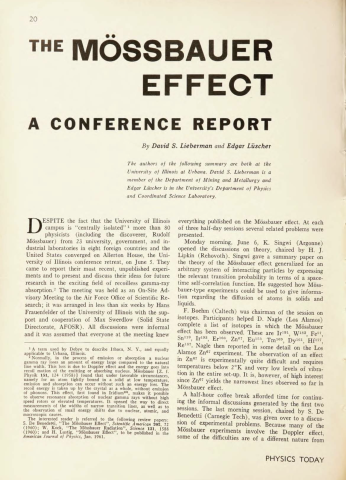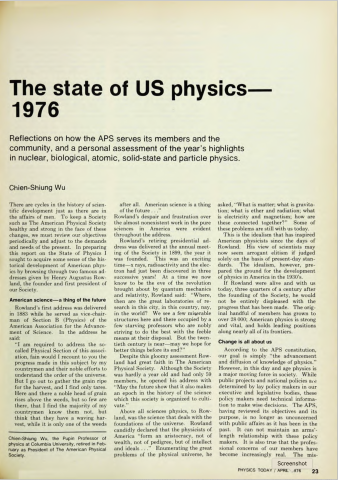Scientific legacy of Stanley Ruby

First presented at the 4th Nassau Mössbauer Symposium, January 2006, and later published in the conference proceedings.
Stanley L. Ruby (1924-2004) made major contributions to Mossbauer spectroscopy and was the first to suggest the feasibility of observing the Mossbauer effect using synchrotron radiation. In this article we recall his scientific legacy that have inspired his scientific colleagues.
During his active scientific career, Stanley Ruby always addressed most fundamental aspects of physics without being a "reductionist" - asking questions regarding the fundamental interaction of electromagnetic waves with matter - nucleons, atoms, molecules and the condensed matter, and answering these questions with unique demonstration experiments. This recollection paper is intended to be a brief compilation of Stanley Ruby's selected contributions. They are creation and annihilation of acoustic phonons, chopped gamma-rays, and jump diffusion in condensed matter. In addition, Ruby's nuclear physics background fitted best for him to identify many new candidate nuclear resonant transitions across the nuclear periodic table; and his grasp of chemical physics led to the development of isomer shift systematic among isoelectronic compounds of 5s-5p atoms. Finally, Ruby's most pragmatic suggestion in 1974 to use synchrotron radiation to observe nuclear resonance, and its eventual demonstration, addressed many fundamental aspects of collective nuclear excitation process and gamma-ray coherence. Furthermore it opened many new avenues of application of the tool to a broader area of science which otherwise would have been impossible with the traditional approach of using radioactive sources in performing Mossbauer spectroscopy measurements.
"Scientific legacy of Stanley Ruby"—a longer version of Gopal's tribute
Wu named associate professor of physics at Columbia
After having been restricted to a research role only, Chien-Shiung Wu is finally recognized with a tenure track position in the Columbia physics faculty. Previously she has mentored students but now she begins formally advising grad students.
Historical timeline: The Rustad-Ruby experiment in context
Physics timeline goes here
Never-published images of Rustad-Ruby apparatus
Stan's academic leave from Westinghouse was reported in Physics Today
Stan encountered Wu at the first big Mössbauer meeting at Urbana in July 1960
The Mössbauer effect: A conference report

Stan presented paper at the first big Mössbauer conference. He encountered Wu in Urbana for first time since 1958. Conference organized by Frauenfelder and Swerdlow. Lipkin was a key participant.
DESPITE the fact that the University of Illinois campus is "centrally isolated" 1 more than 80 physicists (including the discoverer, Rudolf Mossbauer) from 23 university, government, and industrial laboratories in eight foreign countries and the United States converged on Allerton House, the University of Illinois conference retreat, on June 5. They came to report their most recent, unpublished experiments and to present and discuss their ideas for future research in the exciting field of recoilless gamma-ray absorption. 2
The state of US physics—1976

Wu was President of the American Physical Society in 1975-76. This is her state of the profession.
There are cycles in the history of scientific development just as there are in the affairs of men. To keep a Society such as The American Physical Society healthy and strong in the face of these changes, we must review our objectives periodically and adjust to the demands and needs of the present. In preparing this report on the State of Physics I sought to acquire some sense of the historical development of American physics by browsing through two famous addresses given by Henry Augustus Rowland, the founder and first president of our Society.
Let us now look at the state of physics, which I find to be healthy and sound. For some fields of physics, certainly for particle physics, the year just past has been exhilarating. But American physics in general seems to hustle along with such enormous vigor and success that it will be difficult to cover all developments in detail. Forgive me if I sound partial to those fields with which I am more familiar—remember the old saying that to a shoemaker, there is nothing like leather.
Nuclear physics: Last June I attended an International Conference on High Energy Physics and Nuclear Structure at Santa Fe and Los Alamos, and was very much impressed by the size of the delegations from various countries. It reminded me of the early 1960's, when large numbers of American physicists often attended conferences abroad. Now the direction of flow appears to be reversed. We listened to many reports of experimental breakthroughs made with the new generation of accelerators here and abroad. Clearly a new era in nuclear physics has just begun: